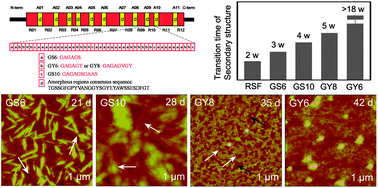Comparison of four synthetic model peptides to understand the role of modular motifs in the self-assembly of silk fibroin
Abstract
To understand the effects of the modular motifs on the silk fibroin self-assembly, regenerated silk fibroin (RSF) and synthetic SF model peptides (GS6: GAGAGS; GS10: GAGAGSGAAS; GY8: GAGAGVGY; GY6: GAGAGY) were prepared and then their self-assembly behaviors were investigated by atomic force microscopy, scanning electron microscopy, attenuated total reflectance Fourier transform infrared spectroscopy, and circular dichroism. The self-assembly behaviors were dependent on modular motifs, amino acid compositions, and concentrations. At relatively high concentrations, GS6 and GS10 self-assembled from disordered aggregates (random coil) to nanofibrils (antiparallel β-sheet), and GY8 self-assembled from disordered aggregates (random coil) to small nanolayer-like features (antiparallel β-sheet). At relatively low concentrations, GS6, GS10, and GY8 experienced a height decrease of protofilament features from 0.8 ± 0.1 nm (random coil) to 0.6 ± 0.1 nm (antiparallel β-sheet). GY6 did not self-assemble at relatively high or low concentration. The secondary structure and morphology transition times of RSF and SF model peptides were: RSF < GS6 < GS10 < GY8 < GY6, which implied that the effects of the modular motifs on β-sheet formation of SF self-assembly were: GS6 > GS10 > GY8 > GY6. These results provide useful insights into the role of modular motifs in the self-assembly of silk fibroin. Furthermore, our work will be beneficial to the peptide sequence design of silk-based biomaterials with targeted properties.

- This article is part of the themed collection: Silk and silk-inspired materials

 Please wait while we load your content...
Please wait while we load your content...